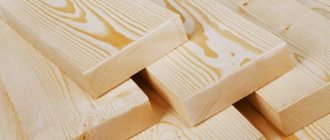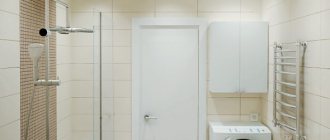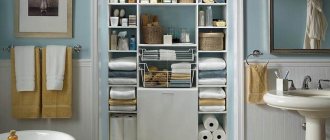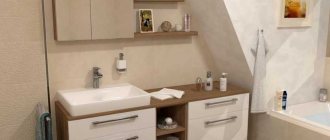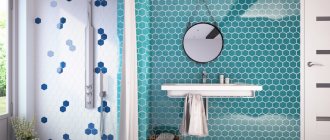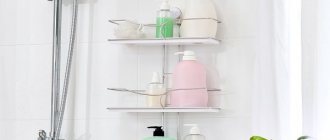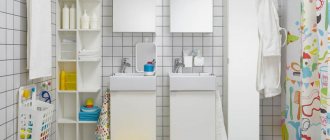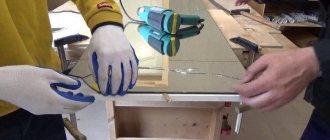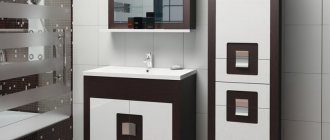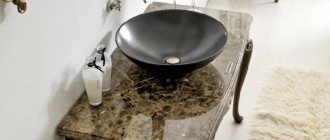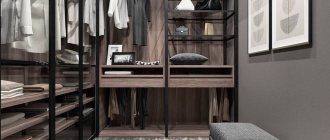DIY toilet cabinet doors in the bathroom.
The toilet is the most visited room in every house or apartment. When arranging it, most owners try to choose classic repair schemes, i.e. install wall accessories on a tiled surface. In addition, such a room often serves as a small storage room for all kinds of cleaning products. This is what a plumbing cabinet is made for. It can accommodate a water supply and control system device. The structure itself is placed behind the toilet.
The doors for the closet in the toilet can be made different and you can choose the appropriate design solution.
Materials
Plumbing cabinet doors can be classified based on the material used to make them.
The range available on the market includes louvered doors made of wood. They are sold everywhere and are in great demand. In order to avoid mistakes associated with purchasing products of this type, the main thing is to choose the correct size. There are some nuances to the operation of wooden products - before installation they must be treated with stain and varnish. Applying these compounds will help protect the wood from moisture present in the room. Doors made of wood are often additionally decorated with various patterns, perforations, and carvings.
- You can cut a chipboard door yourself and install it on the cabinet using hinges. This design option is the simplest and fastest, as well as economical.
- Tile doors, which are mounted on a special frame, are another way to create a closet in the toilet. Thus, in the bathroom, the walls of which were also covered with this material, there will be doors for tiles, identical to the appearance of the walls.
- Mirror doors can be made by attaching a mirror to a sheet of plywood of the required size. Such mirror inserts in the room allow you to slightly visually expand the area of the room.
- There are cutting-edge materials that can be used as doors. One of these options is the use of roller shutters. Metal products, plastic products and others are produced. With the help of roller shutters you can easily choose the right color for any bathroom interior. There are slatted shutters that are controlled using a remote control.
- Blinds are more affordable. They are presented in a wide variety of colors; you can order almost any size of such products.
- Doors can be made of plastic. The material is easy to maintain and does not require special surface treatment, as it has a good level of moisture resistance.
- Small textile curtains are a practical solution for arranging a sanitary closet. No less popular are polyethylene products, which can greatly decorate the interior of a room.
- Glass products framed with aluminum profiles are a convenient option for doors, since the material is not afraid of moisture. At the same time, glass provides good sound insulation.
No. 3. What to consider when choosing roller shutters for a toilet?
Plumbing roller shutters differ in a lot of parameters, and, first of all, these are:
- lamella material;
- profile type;
- type of locking element;
- the type of mechanism that sets the canvas in motion;
- type of mechanism control;
- dimensions of the structure;
- design.
Of course, few people want to install powerful steel shutters with a reinforced profile in the toilet. Rather, this is an excellent option for protecting window openings. For a bathroom, a simpler design is suitable, but certain nuances of its execution will, of course, depend on personal preferences, as well as the type of toilet (public or private).
How to choose a plumbing hatch
IKEA cabinet
Invisible hatches for tiles
When choosing a hatch for a renovated toilet based on external characteristics, you should decide how important it is to make it invisible. If there are no increased design requirements, then it is quite possible to get by with a plastic or metal plumbing product at an affordable price of 300-500 rubles
However, these materials have disadvantages:
- the plastic is not strong enough and stands out against the background of the wall;
- if the metal hatch is not intended for tiling, then it will stand out against the background of the wall, even after painting.
“Invisible” cameras with a complex opening mechanism are conquering the market, but they are also more expensive. If you want to make a hatch part of the interior, you will have to spend several thousand rubles. The cheapest high-quality design of a standard size will cost at least 3,000 rubles. Invisible plastic analogues will cost a little less.
The appearance of the final result will depend on the amount the buyer expects: expensive product options can be made to order from original materials.
Here are some more tips for choosing a plumbing door for an updated toilet:
- for painted walls, it is recommended to choose hatches made of metal, since paint adheres to them better than plastic;
- if the box where the plumbing fixtures are installed is tiled, then it is more logical to purchase a hatch with sliding hinges that matches the design;
- if the plumbing hatch is located in a narrow toilet above the toilet, then it is better to install a model with a vertical door opening;
- if the hatch will be installed on the ceiling, you should choose structures with low weight, for example, plastic ones;
- for installation on the floor, choose durable metal models with a metal thickness of at least 4 mm;
- if the door interferes with servicing devices installed in a niche, then it is recommended to choose a version with a removable door.
A custom hatch will cost 2-3 times more than a similar one. When ordering, the dimensions, side for hanging hinges, finishing, and material of manufacture are discussed separately.
Roller shutters
Remember the roller shutters that are often used to close small retail establishments at night? Similar roller shutters to hide pipes can be made in the toilet. They are distinguished by their rigid design and are quite convenient to use. There are two disadvantages:
- Relatively high cost. For example, plumbing roller shutters measuring 80x100 cm can easily cost about 5,000 rubles, depending on the city.
- Large folding box. See the ledge in the next photo? This is where the blinds roll up. The cassette can also be placed inside the “cabinet”, but only if space allows.
An example with a box inside is just in the next photo.
If you are confused by the “cold” and uncomfortable appearance of roller shutters, know that they can also be in color or even with a pattern.
Materials
How to choose and install louvered doors for a closet: painting, maintenance, repair
The classification of products for decorating cabinets in the toilet is also carried out, taking into account the type of raw materials used for the manufacture of functional structural elements. Today, consumers have several options to choose from
Wooden
Wood is a widely used material for the manufacture of sashes of various modifications. In order for the product to have a long service life, it is worth taking into account the specifics of the room where the wooden sashes will be installed, namely high humidity, in light of which the products will require pre-treatment with protective compounds that will prevent deformation of natural raw materials from contact with a humid environment.
Chipboard
Budget material used for the manufacture of sashes. Such raw materials are quite suitable for making your own doors to a sanitary cabinet. Chipboard doors are easy to install and are secured using standard hinges.
Tile
This material is in demand for structures with invisible doors. This option is in demand when you want to hide the cabinet from view, but at the same time make the most of the existing niche.
Mirror models
A popular and attractive option for cabinet doors, which will be relevant for combined or separate bathrooms. A special feature of this model is the ability to visually expand the area of the room and emphasize the design of the walls in this area. You can implement a similar idea of designing a functional design by purchasing a finished product or by independently attaching the mirror to an additional fixing material, which can be plywood.
Plastic products
This category of products includes modern versions of blind doors, roller shutters, and classic swing doors are also made from polymers. The raw material is in demand due to its wide color palette, resistance to dampness and contact with water, in addition, the material is easy to care for.
Textile
Textile door options will be no less attractive and functional. The fabric can have a special impregnation, thanks to which it will remain resistant to moisture and will also keep its shape. Thanks to this design, you can make an interesting and bright accent in the room, in harmony with the overall style.
Glass
A beautiful and functional variety that allows you to make your closet beautiful and practical. The variety of textures, as well as the possibility of applying various patterns, makes glass doors quite popular among consumers. In addition to its visual appeal, this material is notable for its long service life, which will be important for rooms with high levels of humidity.
Ready-made solutions for DIY installation ↑
After counting the points where it is necessary to install rotary wells, the type of container is selected. Manufacturers offer a sufficient number of ready-made structures of different sizes. The main materials from which sewage tanks are made:
Reinforced concrete.
Fiberglass.
Polypropylene, polyethylene.
Polypropylene rotary wells
For home sewage systems, rotary wells are made from composite and polymer materials. Designs of different configurations, with the possibility of selecting a finished product with full preparation for pipe routing.
Holes for tapping are made in sizes equal to standard pipe diameters
If the container is intended for both inspection and repair, select a tank with a larger diameter. The height of finished products varies. In non-standard conditions, prefabricated plastic structures with fasteners for installing rings are used.
Polyethylene wells are multilayer products made using seamless technology. The material is sealed, but quite soft: in hard rocks with a lot of stones, an empty tank can deform under soil pressure.
Factory rotary wells with splitters
Polypropylene wells are highly durable and can be installed in any conditions. The construction is welded. The walls are made with stiffeners.
Plastic container with a sealed hatch
Fiberglass products are used when working at great depths, in complex rocks, and in soils with high year-round groundwater levels. Heavy-duty walls can withstand increased loads. Such wells are installed at the junctions of branches of central sewer mains.
Composite Swivel Tank
Advantages of polymer products:
Low price.
Light weight.
Easy to transport and install.
Finished rings made of reinforced concrete are installed as reinforced rotary control wells. Products with particularly low wall permeability are chosen - such concrete does not allow groundwater to pass into the container.
Standard ring sizes
Structures of varying levels of complexity are assembled from reinforced concrete parts. Main parts for assembling a rotary well:
A plate up to 20 cm thick to protect the wiring. Select the product according to the turning diameter.
Rings: factory products with locks are connected to each other until the required height is achieved. When ordering individually, manufacturers can make holes for the entry and exit of pipes according to the drawing.
Necks and ceilings with lids. The neck is equipped with a ladder and a hatch cover.
Parts for assembling a reinforced concrete tank
Tips and tricks for use and care
Review of locks for metal cabinets, what models are available
Professional plumbers give several recommendations for the further operation of inspection hatches:
- The hinges of the plumbing hatch must be periodically lubricated with appropriate means, for example, lithol.
- Over time, the door may sag slightly under load. To make adjustments, use a hex wrench to correct the position of the hinges, and, consequently, the door.
Plastic and metal hatches are gradually losing popularity, giving way to invisible hatches that meet modern design requirements. These products have a presentable appearance, but have complex installation.
Marking
It is performed directly on the ceiling, floor and walls of the toilet.
Accurate markings are the key to a strong and durable structure
It is done this way:
- there is the most protruding point on the communications, from which they retreat 3-5 cm and mark a line with a pencil;
- then take a laser level and draw a straight line between the ceiling and floor, passing along this mark. If you don’t have a level at hand, you can use a plumb line with a dye thread;
- the same actions are performed on the opposite wall;
- markings around the installation are made with a distance of 5 cm from the frame;
- then the horizontal surfaces are marked, for this we need a corner;
- we place a corner to the wall at the intersection with the floor and draw a line perpendicular to the vertical mark at an angle of 90 degrees;
- We perform the same actions on the other side;
- on the ceiling we do the same;
- draw a parallel line above the installation, level with a deviation of 4 cm.
The marking can be considered completed. We begin to install the metal frame.
Markings applied to walls, floors and ceilings
Plastic doors for sanitary cabinets
Plastic doors for a toilet cabinet are the easiest to install and, importantly, will fit seamlessly into any interior. Another important advantage of plastic products is moisture resistance and resistance to other types of influence.
Plastic doors come in a wide variety of designs, which allows you to choose a model for any style solution
A wide color palette provides plastic products with enviable popularity
Such doors are easy to clean; a simple damp cloth is enough, and in case of heavy contamination, you can use various cleaning agents without fear of harming the material.
Masking pipes - a necessity or a whim?
So, your toilet is probably no exception, and it, like most rooms of this type, has water supply connections. Should they be closed? Only the homeowner can answer this question, based on the general style of the apartment and his own aesthetic ideas. We can only say with certainty that closed pipes are:
- aesthetically pleasing;
- convenient (easy to clean);
- functional.
There is an opinion that first you will have to replace the old iron pipes with modern plastic ones, and only then mask them. This is partly true: it is more convenient, safer and more practical. However, if replacement of the water supply is not planned or is postponed, the pipes in the toilet will continue to spoil the overall appearance.
Characteristics of materials for water supply pipes
Plumbing doors
In apartment buildings, all communication systems run along the wall of the bathroom, supplying clean water and removing liquid waste, which does not paint the sanitary room at all. It is also worth noting the small dimensions of the toilet, which should be taken into account when trying to disguise communications. The optimal solution was sanitary cabinets or doors.
The design of the product allows you to stylishly disguise communication systems, while maintaining easy access to them.
A sanitary cabinet can imitate a wall lined with tiles or stone, look like a full-fledged piece of furniture, or disguise itself as horizontal blinds. An interesting stylistic solution would be the door to the toilet in the same color and format as the door of the sanitary cabinet behind the toilet. This set of doors is produced by some manufacturers, and the product can also be made to order in organizations that provide similar services.
The small size of the bathroom does not allow the installation of full-fledged sliding door structures, so most often the communication is sheathed with moisture-resistant slabs, in which a small niche is left for the doors. The small size makes it possible to install hinged doors that provide access to equipment, for example, a boiler or water heater. But most often, one or two doors are installed, fixed on special fasteners on the inside of the niche, which, if necessary, can be easily removed and inserted back.
Roller shutters of suitable size are made to order, made of lightweight, yet durable, moisture- and wash-resistant materials.
Hiding pipes in walls
This method may seem the most suitable. They made a groove in the wall, strengthened the communications there, sealed them with mortar and forgot about them. It’s beautiful, good, and the wall is even, isn’t it? But what if an emergency occurs during operation and you need to hammer into the walls again and look for a leak?
In order to protect yourself from this for a long time, it is necessary to take a number of measures before walling up pipes in the wall:
- make competent and correct wiring;
- make sure the joints are tight;
- test the heating system at high pressure, much higher than operating pressure.
Moreover, the hydraulic test is recommended to be carried out over several days. And only after you make sure that the joints are dry and no other problems have arisen, you can seal the pipes into the wall with cement-sand mortar.
At the same time, do not forget that when fixing heating and water supply pipes in the groove, it is necessary to leave space for their compensatory expansions.
Plasterboard boxes
Installation of a plasterboard box
Plasterboard pipe boxes are used everywhere today due to the remarkable ability of this material to be easily cut, bent in any direction and installed. And the cost of gypsum board sheets is affordable to almost everyone.
What is needed to hide communications in such structures? The first thing you need to do is make a drawing of the future box, marking on it where the pipeline control points will be located - in these places you will need to install windows with doors. Having calculated the amount of material, you can begin building the box.
It is better to make the frame for it from metal profiles. Wooden blocks tend to change their geometry under the influence of dampness or dry air, which often happens in rooms such as a bathroom or toilet.
But this is where b o
most of the communications. Due to dampness, fungus can form on the wooden elements of the frame, which will destroy the entire structure of the decorative box.
The advantage of this method of masking pipes is that:
- You can do all the work yourself;
- at any time you can dismantle the sheets of drywall without much effort and put them back in place;
- Unlike walling up, there is the possibility of access to communications in the wall.
Plastic panels
This method is suitable for rooms such as a kitchen, bathroom or toilet. Plastic products are easy to clean, which is an important condition when choosing a material for decorating pipes.
A wide variety of plastic wall panels in texture and color have made these materials in demand and popular. The construction of a box from plastic panels is carried out according to the same principle as plasterboard structures.
Overhead decorative screens
Decorative panel for pipe and battery
Today, there are a wide variety of screens for radiators and pipes on sale, which will not only disguise the unsightly appearance of communications, but also decorate the interior of the room.
By connecting pipe covers with battery screens, you can get shelves and tables. They will protect children from injury as a result of accidental contact with these communication elements.
False wall
This design is performed when it is necessary to hide the vertical risers found in each apartment of a multi-story building.
A false wall is erected like any other plasterboard box. This method will slightly reduce the living space, but if you use your imagination, you can arrange niches for books or something else in this design.
Decoration of risers
Here the imagination of designers is limitless. You can make a vertical box and lighting. You can use the riser as a stand for decorative flower arrangements. It all depends on your desire and capabilities.
Differences between plumbing and interior doors
The main difference between sanitary ware and interior tiles is their smaller size. Back in Soviet times, during the construction of multi-storey buildings with small-sized apartments, standard sizes of door leaves in hygienic rooms were introduced: 1.9 m high and 0.55-0.6 m wide.
The second important difference is the material of manufacture, which should be light and moisture resistant. The lightness of the material is necessary due to the thinness of partition walls in sanitary premises, and resistance to moisture allows the product to maintain its shape and aesthetic appearance throughout its service life.
Materials needed to close the pipes in the toilet in a box
A false wall and box are the most common way to disguise pipelines in a cramped apartment.
To work you will need:
- sheet of wall plasterboard or PVC (as an option, sandwich panel);
- profiles and dowels for them (on average three for each rack and guide);
- metal screws;
- putty and finishing materials (this could be tiles, wallpaper, paint or emulsion).
To decide on the material for cladding, you need to take into account the humidity in the room, financial capabilities and construction skills.
On a note
. You can use a sandwich panel coated with polymer or already covered with plasterboard. This will reduce the work time, since you will not need to cover the frame yourself.
Tools you will need: a tape measure, a level, a drill, a screwdriver, a knife for cutting drywall, sandpaper for cleaning up cuts, a spatula and, if necessary, a brush for finishing work.
To decide on the material for sewing
, it is necessary to take into account the humidity in the room, financial capabilities and construction skills.
When installing drywall, do not allow it to touch the pipelines. Condensation getting on the drywall will significantly reduce the service life of the box.
- Drywall
can absorb moisture, which can lead to mold or mildew. However, they are easier to sew and cost less. The price of a standard sheet is 215 rubles (Knauf) (you can read more about the sizes of gypsum board sheets and calculation rules). - Sheathing with plastic (PVC)
is more difficult, but it is moisture resistant and durable. In addition, PVC does not require finishing work - the panel can be of any color. The price is correspondingly higher. But do not forget that by purchasing PVC, you can save on wallpaper or tiles. The price of packing panels for ten sheets is from 700 rubles (size 1 by 6 meters, thickness centimeter). - Sandvi h-panel
, in addition to moisture resistance, also has such an important quality as the ability to retain heat. After all, its base is made of insulation (expanded polystyrene, polyurethane foam or mineral wool). The cost is comparable to plastic panels - from 800 rubles per square meter (one centimeter thick).
Installation of the box always starts from the bottom of the wall. The profile (bottom guide) is cut to size and attached to the floor using dowels
Types of door configurations for sanitary cabinets
There are a lot of options for what doors can be. You can consider various materials for manufacturing: drywall, plywood, wood, chipboard, tile, mirror and so on. Each of these options has both its advantages and disadvantages.
Hinged doors made of natural wood coated with clear varnish
Double door wardrobe with laminated chipboard doors
According to the type of configuration, you can also choose from a variety of options: standard doors with a traditional opening method, shutters of the blind type, compartment doors, invisible doors or batten doors. It is the last two options that are used most often due to their convenience.
In the photo there are compartment doors made across the entire wall of the toilet
The photo shows a narrow hinged door made of frosted glass
Invisible door
Typically this option is used for painting or tiles. These designs have many advantages, because their design is as well thought out as possible. They close well (tightly), and at the same time allow easy access to meters and other communications.
Such a door is practically invisible and does not attract attention in the interior, because its outlines merge with the tile seams. They have many options for decoration: it can be marble, mirrors, artificial or natural stone. A special mechanism allows you to open the hatch using a pressing motion. The installation must be carried out at the same time as the installation of the cabinet walls, after which it, together with the walls of the room, is lined.
It is better to entrust the installation of such a structure to professionals, since the installation process has many nuances.
Doors with lathing
This option is quite simple and convenient, and it will not cost much at all. Doors with lathing are suitable for any plumbing cabinet. The main thing is to take measurements in advance and purchase the appropriate furniture. Typically, the material for making such doors is wood or PVC. They are easy to install, but you need to prepare the frame block, fastening the hinges and the lock in advance. If the doors are made of wood, take care to cover them with varnish or stain. Plastic specimens do not require additional processing.
Doors with bars provide ventilation to the cabinet and help create a neat interior
The structure of the lathing allows for good ventilation inside the cabinet, but significantly reduces sound insulation.
The photo shows lattice doors covering the boiler for heating water.
No. 5. Mechanism and control
Depending on the type of control, toilet roller shutters can be:
- mechanical (driven by human efforts);
- automatic (set in motion by an electric drive after pressing a button on the wall or on the remote control).
There is no great sense in using an electric drive in sanitary roller shutters - these are not heavy structures, and they do not need to be opened very often. If you consider that a design with automatic control is much more expensive, then this option can be safely dismissed.
, a mechanical drive is best suited . As a rule, two options are used:
- belt drive is based on a belt that is attached to the shaft and the belt roller. A person only needs to pull the tape to activate the structure. This is a simple and cheap mechanism that can handle loads of up to 15 kg. In terms of convenience, this is not the best solution; it requires more effort than a spring-inertia mechanism. Such roller shutters cannot be fixed in an intermediate position. For openings less than 52 cm wide, a belt drive is the only option;
- spring-inertia drive – the most modern and convenient. The design is designed so that it can be fixed in any position, i.e. if necessary, you can only open the opening slightly if access to the entire space is not required. The control handle is located on the lower guide. The process of raising and lowering such mechanisms is as simple as possible, but with a structure width of less than 52 cm, it is impossible to place a spring in it, so the drive cannot be called universal.
Components of a sanitary cabinet
Being an indispensable component of the room, the toilet needs proper arrangement. In order to improve ergonomics, it is equipped with a small wall structure - a plumbing cabinet. It is intended for the following purposes:
- Masking of communications. The opportunity to hide pipes in a compact piece of furniture looks tempting, especially if the room is not large. In addition, this solution allows you to increase the aesthetic appeal of the room and get rid of the problem of exposed communications.
- The emergence of an additional niche for placing bathroom care products and household chemicals. The design can be divided into several zones using shelves, which will make it more spacious and functional.
- Free access to important meters and plumbing components.
- Easy to troubleshoot.
When arranging a plumbing closet for a toilet, you need to make sure that it can accommodate the following elements:
- The cleaning filter is a dirt trap. The design is designed to increase the service life of mixers by deeply purifying water from many impurities and solid particles. The absence of a mud trap will lead to rapid wear of important components of plumbing equipment.
- Water meters. Designed to save money, because... they determine the true cost of water costs and prevent homeowners from having to overpay the tariff.
- Check valves. The task of the nodes is to provide balanced counter functionality. If a pressure difference occurs, this increases the likelihood of water overflow and does not allow you to manually change the values of the water meter. Due to this feature, the installation of sensors is provided for in the standards of management companies.
- Collectors. Designed for uniform distribution of water.
- Water pressure reducers. The devices absorb pressure surges and restore normal operating conditions.
If the plumbing cabinet has the required dimensions, you can install equipment for heating water in it. It can be either cumulative or flow-through.
Why don't builders hide pipes?
The bathroom is rich in all kinds of communications. Sewage pipes, hot and cold water supply, as well as additions in the form of a heated towel rail or heating system are on public display here.
This “openness” is not accidental. Even if the room is spacious enough and the layout allows, builders leave most of the pipes in sight. The reason lies in building codes that directly prohibit the hidden installation of pipes connected by certain types of fittings. For such devices, easy access in case of problems occurs.
Another reason for open installation is the formation of condensation on metal pipes with cold water. Only air constantly circulating around the pipe can effectively remove condensate.
That is why in the bathroom you can see pipes anywhere on the wall, in a corner or in a niche. They can be vertical or horizontal, running under the ceiling or near the floor. A separate class of pipes that need to be hidden are products of different diameters coming from plumbing equipment, as well as toilets with installation.
Not every pipe needs to be hidden Source izhevsk.ru
Types of doors for bathroom cabinets
The main function of a plumbing cabinet is to conceal fixtures and equipment. However, when arranging the structure, it is necessary to ensure free access to the toilet and the main components of communication systems. For this reason, toilet doors must open and close freely.
To cope with this task, you need to choose the right type of door. In particular, you can choose from the following options:
- Hinged doors. This option can be called the standard opening method.
- Invisible doors.
- Framed doors.
- Louvre doors in the toilet.
- Sliding doors.
The installation of each type of plumbing toilet door must be carried out in accordance with its characteristics in order to prevent the formation of bevels and other defects. Otherwise, the appearance of the entire structure may be spoiled.
Types of utility wiring
Before designing the wiring, you should become familiar with what types of such structures exist. There are only three of them. Moreover, one, with pass-through sockets, is practically not used. Therefore, we will not consider it.
Type #1. Serial type wiring
To implement this, taps are made from the cold and hot water supply risers leading to the first consumer. Pipes are laid from it to the second and further. Each water collection point is equipped with a tee, to one of the outlets of which the consumer is connected.
Overall this is a very simple scheme. It can only be used where the number of water consumers is small.
This is due to the fact that if several water collection points are activated simultaneously, the pressure in them will weaken and may be insufficient for the correct operation of the equipment. This is the main disadvantage of series wiring.
However, for apartments with one bathroom and a small amount of plumbing used, this may be the best option. A significant drawback of the system is the inability to turn off one of the plumbing fixtures for replacement or repair.
Serial wiring is extremely simple to implement, but not very convenient to use. However, for small bathrooms this solution may be quite acceptable.
There are many more advantages to sequential wiring. First of all, it is simplicity in design and installation. There will be no complex schemes here, everything is done very simply.
In addition, such wiring is considered the most economical option. The consumption of pipes and other elements will be significantly lower than in other systems, and installation costs are also minimal.
Even a novice plumber can handle the design and subsequent installation of sequential, otherwise tee, wiring
Type #2. Collector type of wiring
The collector type scheme involves connecting each of the consumers to the main line. For this, a special element is used, which is called a collector - a device that distributes water flows.
In a more complex version, and this is best, each collector outlet is equipped with a shut-off valve. Collector-type wiring can be considered the most convenient option to use. There are several reasons for this.
Firstly, the absence of pressure drops in the system. All consumers receive equally good water pressure, even if all water points operate simultaneously.
If the pressure in the system of an apartment or private house is too low for some reason, you can temporarily limit the water supply to one of the consumers, for example, to the toilet, thereby increasing the pressure for others.
The collector type of wiring is more convenient to use than the serial type. In this case, a separate line goes to each consumer, which guarantees no problems with pressure. However, such a system turns out to be more complex in design and installation.
Secondly, the ability to disconnect plumbing fixtures from the water supply if they need replacement or repair.
Thirdly, reliability. In fact, a single pipe goes to each consumer, without any connections or other elements. A leak can only appear in the collector area or near the device itself. Here it will be very easy to find. For this reason, pipes with manifold wiring can be safely installed using a hidden method.
Fourthly, ease of use. If there is a problem with a plumbing fixture and a leak appears, for example, at a faucet, you do not need to crawl under the sink. It is enough to close the shut-off valve on the manifold leading to the faulty device and wait for the specialists to arrive.
Even a woman or child unfamiliar with plumbing can do this. At the same time, all other equipment will work properly.
Professionals recommend using manifolds with shut-off valves for installation in water supply systems. With their help, if necessary, you can easily stop the water supply to a branch or plumbing fixture in need of repair.
However, collector wiring also has some disadvantages. First of all, it will cost the owner more than a sequential circuit. This is due to the fact that it will be necessary to lay a branch to each consumer. This will take a lot more material.
In addition, the installation of manifolds and shut-off valves will be required if the distributors are not equipped with them. And the circuit itself will be much more complicated than a sequential one.
What is a plumbing hatch
Plumbing hatch in the bathroom
The inspection hatch is a product consisting of a frame, hinges and a door, which is secured with a lock.
The advantages of such elements:
- compliance with technical requirements and standards for ensuring access to water supply communications: threaded connections, meters, taps;
- neat and presentable appearance;
- allow you to hide unaesthetic elements of plumbing: filters, pipes, water heater, meters.
The inspection hatch in the bathroom can be installed as:
- a window providing access to the bathtub;
- plumbing door behind the toilet in the toilet;
- the door of a separate cabinet, equipped in a plasterboard box.
After installation of the product, it resembles a cabinet with plumbing fixtures located behind the door.
Recommendations
Installing a box in a bathroom requires caution and compliance with the following recommendations:
- Before installing the box, they check not only the tightness of the joints and the stability of the valves and meters, but also the correct functioning of communications, for example, a sufficient slope of the pipes.
- If the frame of the box is made of wooden beams, it is worth additionally impregnating it with a protective composition. The same procedure will be useful for wood boards.
- At the measurement stage, it is useful to take into account the location of household appliances in order to avoid unnecessary problems in the future.
Toilet with a box system Source mykaleidoscope.ru
Types of ventilation in sanitary doors
Forced ventilation in the wall facing the street can minimize the risk of mold on bathroom/toilet surfaces and musty, heavy air. Ventilation holes in the sanitary door, which can have different sizes and shapes, also allow for the flow of fresh air. In some products, holes are drilled in the lower part and decorated with plastic or other coating; in others, these holes are covered with a grill.
The grille can be rectangular in shape, slightly smaller in width and arbitrary height, or it can be presented in the form of round plastic windows, which can be removed and washed if desired.
Blinds
Blinds are one of the easiest ways to hide pipes.
- Firstly, it’s cheap: prices depend on the required size and city, but on average you can count on 700 rubles.
- Secondly, to order blinds for the toilet, you do not need to call measurers and somehow complicate the process, since there are no subtleties in this. Measure the opening with a regular tape measure and contact us immediately to order.
- Thirdly, blinds are easy to install, since they only need to be screwed to the wall.
If desired, the blinds can also be fixed to the ceiling, but it will depend on its finish.
Another advantage of blinds is the ability to choose them in any color and shade. The classic option is white horizontal aluminum blinds. As practice shows, they fit best into the interior.
But among the shortcomings, it is definitely worth noting that it is not the greatest ease of use. If the pipes are simply hidden behind the blinds and the space is not used in any way, no problem. However, if behind them there are shelves with frequently used things, raising and lowering the blinds every time will not be very convenient. In this case, it is better to pay attention to the doors.
Design Features
The plumbing cabinet is installed on the wall directly behind the toilet. Its main task is to provide the room with aesthetic appeal and protect elements of communication systems from various mechanical damage. Also inside the cabinet you can place several shelves on which hygiene products and household chemicals are stored.
When arranging a sanitary cabinet, you should pay attention to the internal configuration, since its capacity depends on this. However, other components of this design also cannot be ignored.
In particular, we are talking about sanitary cabinet doors. The specific design of these elements, appearance and material of manufacture are of great importance. The degree of protection of devices and instruments located inside the cabinet, the appearance of the finished structure and the efficiency of its use depend on this
It is very important not only to hide measuring instruments, taps and pipes, but also to ensure their accessible location in the interior space.
The second way is to buy a ready-made box
Another option is to use a pipe box. This could be the construction of a home-made structure or the purchase of a finished factory product. The second method is simpler.
The shape and size of the purchased boxes allows you to choose exactly the option that will successfully disguise the outer parts of the pipeline not only in the toilet, but also hide the heating pipes in other rooms.
A significant drawback is that ready-made boxes cannot be used in bathrooms with complex geometry of communication systems. This is when there are a lot of pipes and they are randomly located throughout the room.
Image gallery
Photo from
Metal box to protect communications
A plastic box will help hide the pipes
You can choose the desired color of the box
Ready-made extruded polystyrene box
As for the material and color of the finished structure, there is room for the buyer’s imagination to run wild - it can be chosen to suit almost any room design.
When the desired color is missing from the palette of the material you like, this can be corrected with the help of moisture-resistant paint and a brush.
The improved structure can be installed only after the paint has completely dried. You should look at the jar for the exact time - the manufacturer must indicate this information on the label of its products.
The plastic box has an aesthetic appearance and, if necessary, can be easily dismantled to gain access to the pipe
The installation process is extremely simple - you need to measure the required length with a tape measure and, after marking it with a pencil, carefully cut off the excess part of the structure.
Then attach the box to the wall with fasteners or liquid nails - it all depends on the type of material from which the structure is made and the manufacturer’s recommendations for its installation.
Dimensions and door design for sanitary cabinet
As a rule, the dimensions of the door in the toilet behind the toilet correspond to the dimensions of the cabinet structure. It should be taken into account that these dimensions are individually selected for each room.
Doors must provide easy access to plumbing services
When choosing and purchasing doors or materials for their manufacture, do not forget about the basic installation requirements.
- Small doors (secret) are installed if access to the meter and communications is necessary. It is better to make them with additional windows.
- If we are talking about installing specimens at the full height of the wall, then installation can be done when the pipes are on the surface and positioned vertically.
- For medium-sized options (for example, 55*190 cm), you can consider placing shelves for storing household items.
- When calculating the depth of the box, keep in mind that it should be sufficient to carry out repair work using various tools, because it is often necessary to replace some components.
The placement of doors depends on the location of pipes, meters and other plumbing fixtures
As for design and decoration, there are many options for decorating the facade of such a cabinet. Let's look at the most popular of them:
- Mirror doors. They visually increase the space, and this is a big plus. However, any touch leaves fingerprints on the surface, so cleaning will need to be done more often.
- Roller shutters with a metallic shade. They will look especially advantageous in a modern-style interior. If the interior is made in bright colors, then it is better to give preference to bright colors in the design of the structure.
- Special stickers, photo printing, etc. are suitable for decoration.
- Also, as an additional design, you can use spotlights on the doors, inlays on wooden materials, and tiling.
Briefly about the main thing
The pipe box in the bathroom is an important component of the comfort and aesthetics of the room. It is made from materials that can resist fluctuations in temperature and humidity. More often than others, structures are built from plasterboard with ceramic tile cladding; options made from plastic panels are popular. There is growing interest in using roller shutters, but they do not fit into every design.
When choosing a suitable option, pay attention to the final cost of the project and its compliance with the dimensions of the room. Part of the design is an inspection hatch necessary for access to metering devices and fittings. They try to make it invisible, for which they use the same material as in the rest of the decoration.
Ratings 0
Doors to the toilet for a plumbing cabinet - the 2 most common options
Louvered doors for sanitary cabinets
The biggest advantage of louvered toilet doors is that they are made of moisture-resistant plastic and PVC. It is the appearance that often raises doubts: it will not fit into every interior and not everyone will like it, however, for some design solutions it will be a very good choice.
If we consider this option from a practicality point of view, we must take into account that when opened, the blind system goes up. Access, of course, does not block, but the part of the door that gathers at the top goes into the mechanism, which takes up a significant space in the upper part of the opening. The lower part, made of this material, will require a large number of modifications.
Louvered doors can have an open top frame or a closed one built inside a niche
Well, there is one more significant drawback - the ability to install only in a completely finished opening. If the repairs in the toilet have not yet been completed, the walls have not been leveled, tiles have not been laid or wallpaper has not been pasted, then you should not install louvered doors in the toilet. otherwise, during installation there will be gaps that will need to be corrected.
What to make a camouflage box from
With a successful choice of shape and material, the design of the box in the bathroom will become an organic (or, if necessary, spectacular) detail of the interior. Installation of the box is something like a small redevelopment, so the material is chosen based on the characteristics of the functioning of the pipes.
Popular materials include moisture-resistant plasterboard, PVC panels, decorative MDF board or moisture-resistant plywood. There is also an alternative to pipe insulation in the form of blinds or roller shutters.
Moisture-resistant drywall (GKLV)
There are several types of plasterboard sheets (GKL) on the market; A moisture-resistant type of material labeled GKLV is suitable for the bathroom. Sheets suitable for finishing plumbing units can be easily recognized by their characteristic green color. They are additionally impregnated with antifungal agents, which is a definite plus for wet rooms.
GKLV sheets are suitable both for creating standard rectangular shapes and for producing radius surfaces. True, to obtain a curved shape, special skills will be required.
Box with hatch made of gypsum boards Source stroyfora.ru
When choosing drywall, you must remember the following features:
- Plasterboard sheets weigh more than MDF boards or plastic panels, so installation will require more effort.
- Experts recommend additionally treating the slabs with a moisture-proofing compound. This will increase the structure’s resistance to moisture and extend its service life.
- A collapsible structure made of sheets will not work. Therefore, a hatch must be provided in the box, which will provide quick access to the meter and valves.
- If pipes with hot water (water supply or heating system) are hidden in the box, several holes are provided in the upper part of the structure. They will allow warm air to penetrate the room.
- Drywall is not a finishing material. It can be decorated with the same finish that was used for the bathroom walls, or you can choose a different material. Most often, the panels are sheathed with tiles, but other types of decoration are also used: moisture-resistant wallpaper, paint (preferably latex-based), decorative plaster.
Finishing with tiles Source berizon.ru
Plastic panels
Often the box is made of plastic panels. They have an attractive appearance and are available in a wide range of colors. You can always choose a shade that matches your bathroom design. In addition to aesthetics, plastic has the following undoubted advantages:
- The panels belong to budget finishing materials.
- They have a minimum thickness, so they do not hide the area; This is convenient for a small bathroom.
- PVC panels are waterproof and therefore easy to clean: just wipe the dirty surface with a damp cloth.
- Plastic is a durable material. It is quite flexible, durable and resistant to mechanical damage.
- Plastic panels are easy to install and, importantly, repair. The damaged part is replaced with a new one without destroying the structure.
Design of a small bathroom with hidden pipes Source assets.kemmler.de
Waterproof plywood
In the manufacture of moisture-resistant varieties of plywood, special glue is used; They are also treated with a compound that increases moisture resistance. Materials with the following markings are suitable for the bathroom:
- FC (moisture resistant). The veneers are glued with urea glue, which allows the material to be used in interior decoration.
- FSF (high moisture resistance). Resin phenol-formaldehyde glue is used in production, so the material is characterized by high water resistance. Additional advantages are mechanical strength and special wear resistance. In residential premises, material with an emission class not exceeding E1 is used.
The main disadvantage of waterproof plywood is its high cost. For this reason, it is used less frequently than other materials.
Paint or wallpaper is suitable for finishing a plywood box Source bezkovrov.com
Wood boards
Popular materials in the construction industry: particle boards (chipboards), fibreboards (fibreboard or MDF) oriented strand OSB. They are often used to create a box, focusing on the relatively low cost.
The problem is that their technical properties are not designed for continuous use in a damp room. The surface tends to absorb water vapor, so the service life of wood boards in the bathroom does not exceed 10 years. To increase durability, the surface is painted or varnished.
Both wooden beams and metal profiles are suitable for the manufacture of a supporting structure; To fix the plates, use ordinary self-tapping screws. The finished box needs further finishing. If you used a laminated MDF board, you can refuse decoration.
MDF with tile imitation Source sense-life.com
Materials for the manufacture of sanitary doors
When manufacturing door blocks for sanitary premises, manufacturers focus on moisture-resistant materials and coatings:
Glass is resistant to water and steam, easy to clean, and retains its original appearance for many years. The safety and strength of the material is ensured by hardening or the triplex system. If there is a possibility of a fight, the tempered glass is showered with small crumbs that are not capable of harming a person. Triplex is made of several thin layers of glass glued together with a special film polymer, so in the event of a fight, all the fragments remain glued to the film. Glass design involves various effects (matte, mirror reflection, tinting, corrugation, etc.) and fittings or inserts made of durable and lightweight aluminum.
Solid PVC plastic is inert to moisture and temperatures; due to its polymer composition, it is not suitable for the emergence and development of mold and fungal spores. The main advantage is the ability to make the product according to individual sizes, in any stylistic decision and shade.
Chipboard panels impregnated with a special composition with moisture-repellent properties. The panels are usually finished with natural veneer or eco-veneer. The only drawback of doors is their heaviness, which is why manufacturers usually produce doors whose inner part consists of many empty cells, reminiscent of a honeycomb, which is sheathed on both sides with chipboards of small thickness, and then comes the thinnest layer of coating.
Solid wood. Products made from natural solid wood are characterized by a high level of strength and reliability, and have a luxurious appearance. The wood blank for the door must be thoroughly dried in production, soaked in several layers of antiseptic and moisture-repellent compounds, and then tinted in the required color. Wooden doors are quite heavy, so they are not suitable for installation in rooms with thin walls. There is also a possibility of buying a counterfeit product, the material for which has not been completely dried and treated with compounds, which will ultimately lead to the appearance of mold, bacteria and bugs inside the wood.
Masking communications with plastic panels
This is a fairly simple method that even those who have never dealt with this material can do. There are a lot of instructions for creating a box on the Internet, the material itself is inexpensive, therefore, the costs will be low. By using plastic as a material to hide sewer pipes in the toilet, we end up with a finished product, unlike, say, drywall, which will still need to be decorated after installation.
It is advisable to treat the space closed by the box with an antiseptic solution so that fungus and mold do not appear in the enclosed space. It is best to provide a ready-made door for the box, this will be more convenient when servicing the devices located there - water meters.
Modern blinds for the bathroom and toilet: their varieties
Considering that quite difficult conditions are created in the bathroom: high humidity and sudden temperature changes, it is not recommended to purchase blinds made from expensive materials. They will quickly lose their original appearance. It is best to give preference to simple but practical models with a higher quality frame and a reliable deployment system.
Material for making blinds:
- An excellent solution is to install metal blinds. They are not prone to deformation and are durable, as they are coated with a special compound that protects against corrosion.
- Installing wooden blinds will cost you a lot more. However, these models are environmentally friendly, are able to provide high-quality noise insulation and have a varied palette of colors.
- A profitable option is to purchase plastic blinds. They have a low price, are easy to care for, do not deform and do not attract dust.
- A truly economical solution is to install fabric blinds. This fabric curtain is very hygienic and easy to care for using regular detergents.
The most common type is roller blinds. This is a very reliable design, thanks to it you can hide various plumbing elements and a boiler. The cost of roller blinds is much higher than regular standard blinds. They are made of wood or metal. Roller blinds are wear-resistant and will serve you for quite a long time.
Invisibility hatch trim
An invisible structure without finishing does not look aesthetically pleasing enough. It can be painted:
- The surface is coated with primer and putty.
- Use wet putty to make a cut around the perimeter of the door.
- The dry putty is sanded with emery cloth and finally covered with paint along with the walls of the bathroom or toilet.
If it is decided to tile the hatch, then proceed as follows:
- The walls and hatch doors are coated with primer.
- A load is hung on the back side of the door, which will be equal in weight to the weight of the cladding. This will prevent the product from sagging in the future.
- The opening mechanism must be closed (blocked) with a special clip during installation of the tiles.
- The tiles are glued using regular tile adhesive or liquid nails.
- The edges of the tiles should protrude beyond the contours of the door. The projection on the hinge side is from 5 to 50 mm.
- The glue is not applied to the entire surface, but only to the part that will be adjacent to the door.
- Excess glue is removed after a day.
Then fill the seams with silicone sealant, including around the opening perimeter, selecting the composition according to color:
- The edges of the tiles along the seam are protected with masking tape on both sides. However, the sealant may also stick to the tape, making it difficult to remove without damaging the seam. To avoid this situation, the tape is coated with vegetable oil and removed as soon as the seam is closed with sealant.
- Excess composition is removed with a finger dipped in soapy water or a soft plastic spatula. After this, the hatch is left for two days. During this time, the sealant will dry completely.
- After opening the hatch, trim the sealant where necessary if the door sticks.
The aesthetic side does not lag behind the technical side. Sometimes the hatch is not masked, but rather highlighted. For example, an interesting option looks when the hatch is finished with mirror tiles, then it also performs the function of a mirror.
Exquisite hatch models are created not only from plastic and metal, but also from glass and wood. Wooden structures are covered with stain, varnish or wax. Glass doors to a sanitary cabinet in a toilet do the following:
- made of brown glass;
- made of glass with a pattern;
- made of textured glass;
- with a matte pattern;
- tinted to match the color of the tiles;
- translucent.
A unique version of an inspection hatch is a roller shutter. Often they cover the entire wall without making a separate hole, and thus create a false wall. Any drawing or photo can be applied to the roller shutters.

